 image by Ivan Sache, 23 September 2018
image by Ivan Sache, 23 September 2018
Last modified: 2024-03-02 by rob raeside
Keywords: education |
Links: FOTW homepage |
search |
disclaimer and copyright |
write us |
mirrors
See also:
Other Institutions:
 image by Ivan Sache, 23 September 2018
image by Ivan Sache, 23 September 2018
Institución Educativa Rural La Rastra was established in 1949 in Puerto Milán
(Caquetá Department), as Escuela Vocacional para los Colonos del Orteguaza Medio,
on a plot offered by the Texas oil company to the Capuchin Order.
Since 1981,
the school has been managed by the Missionary Sisters of Mary Immaculate and
Saint Catherine of Sienna, better known as Lauritas, a congregation founded in
1914 in Colombia by St. Laura Montoya Upegui (1874-1949; canonized on 12 May
2013 by Pope Francis; officially celebrated in Colombia on 21 October).
https://internadolarastra.es.tl/
School website
The flag is horizontally divided white-celestial blue. This is
the Marian flag, used since 1953 when the school was renamed to Villa Fátima and
placed under the protection of the Blessed Virgin.
https://internadolarastra.es.tl/S%CDMBOLOS-INSTITUCIONALES-.htm
School
website
Ivan Sache, 23 September 2018
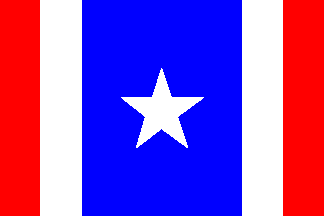 image by Ivan Sache, 27 June 2014
image by Ivan Sache, 27 June 2014
Colegio Psicopedagógico La Sabiduría was established in 1991 in El Mortiño
(Bogotá) by Margoth Alied Mora Arévalo and her husband Raúl Ruiz González.
The flag of the institute is vertically divided red-white-blue-white-red
(1:1:4:1:1) with a white star in the middle.
Photos:
http://colegiolasabiduria.edu.co/uploads/7/2/1/1/7211433/__8280324_orig.jpg
http://colegiolasabiduria.edu.co/uploads/7/2/1/1/7211433/__1769726_orig.jpg
Ivan Sache, 27 June 2014
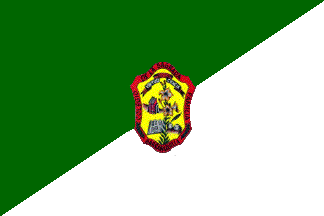 image by Ivan Sache, 20 October 2014
image by Ivan Sache, 20 October 2014
Colegio de La Sagrada Familia was established in 1953 in Baranquilla
(Atlántico Department) by the Tertiary Capuchins, a congregation founded in 1889
by Luis Amigó Ferrer and active in Colombia since 1905.
The flag of the institute is described in Chapter 1.2.2 of the institute's
Etiquette Guidebook, as divided green-white according to the ascending diagonal,
with the institute's emblem in the middle. Green is a symbol of the ecological
orientation of the Franciscan ideal, which encourages to love the natural
environment and to take care of it, and exalts hope as one of the theological
virtues. White is a symbol of virtue, purity, transparency, and of the Christian
values.
The emblem of the institute is described in Chapter 1.2.1 of the institute's
Etiquette Guidebook. The emblem was designed in 1970, when a group of students
and teachers decided to adopt an emblem featuring the red and yellow colours and
the Bible as a symbol of spirituality.
Source:
http://www.colsagradafamilia.com/directivos/Manual_de_Convivencia.pdf -
Institute' website
Ivan Sache, 20 October 2014
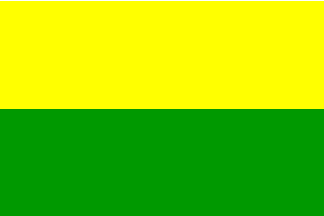 image by Ivan Sache, 02 July 2014
image by Ivan Sache, 02 July 2014
Institución Educativa Tecnica La Sagrada Familia is located in Ibagué (Tolima
Department).
The flag of the institute is horizontally divided yellow-green.
Source:
http://www.ietsagradafamilia.edu.co/portal/?cat=6 - Institute's website
Ivan Sache, 02 July 2014
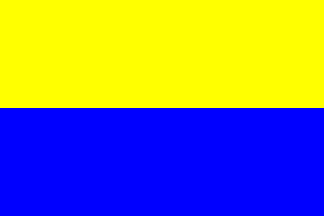 image by Ivan Sache, 17 July 2014
image by Ivan Sache, 17 July 2014
Colegio La Salle was established in Cúcuta (Norte del Santander Department)
by the Institute of the Brothers of the Christian School (Lasallians). Liceo del
Santísimo Niño Jesús was founded on 15 May 1931 by Friar Idinael Enrique,
director of Colegio Sagrado Corazón de Jesús, as a private branch of that
institute. The new institute soon superseded Colegio Sagrado Corazón de Jesús by
its number of students. The Provincial Lasallian chapter decided in 1940 to
withdraw from Cúcuta following a dispute with the municipal administration;
after protest by the population of the town and by the teachers, Father Alfonso
Juan was allowed to establish a new, smaller Lasallian institute on the Villa de
Fidelia estate, purchased on 12 December 1941. The building of the new institute
would be delayed until 11 June 1951; the institute was eventually blessed on 26
January 1954.
The flag of the institute is horizontally divided
yellow-blue.
http://www.lasallecucuta.org/imagencorporativa/corporative-la-salle.html -
Institute's website
Ivan Sache, 17 July 2014
Chapter 7.2 of the institute's Etiquette Guidebook says that the flag was
designed in 1954 by the first director of the institute, Friar Venidlo (Antonio
Bedoya). The flag features the sun dissolved in its folds and the blue of the
heavens flourishing like childhood and youth.
Source:
http://lasallecucuta.org/manual.pdf - Institute's website
Ivan Sache, 19 October 2014
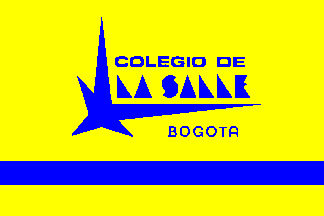 image by Carlos Thompson, 17 March 2003
image by Carlos Thompson, 17 March 2003
Colegio de La Salle, Bogotá, Colombia (La Salle School, Bogota) - This is my school, so I know how
the flag looked like, and I checked with a black and white
picture. A yellow field with a blue band bellow, in the
middle there is the Star of the school (every La Salle
institution has its own star), with the words COLEGIO DE LA SALLE
above the star and BOGOTA bellow.
Carlos Thompson, 17 March 2003
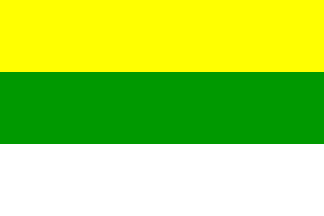 image by Tomislav Todorovic, 12 March 2017
image by Tomislav Todorovic, 12 March 2017
Institución Educativa La Salle de Campoamor is located in the Campoamor
borough, Guayabal, Medellín, Antioquia Department.
The flag of the
institute is horizontally divided yellow-green-white.
http://www.sallecampoamor.edu.co/index.php?idmenutipo=25&tag=col -
Institute's website
Ivan Sache, 24 September 2014
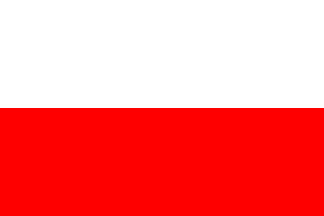 image by Ivan Sache, 24 September 2014
image by Ivan Sache, 24 September 2014
Liceo Infantil La Salle is located in Ibagué (Tolima Department).
The flag of the institute is horizontally divided white-red.
Source:
http://liceoinfantillasalleibague.blogspot.fr/2013/04/bandera-liceo-infantil-la-salle.html
- Institute's blog
Photos:
http://liceoinfantillasalleibague.blogspot.fr/2014/03/elecciones-personero-y-comisario-de-paz.html
http://liceoinfantillasalleibague.blogspot.fr/2013/08/celebrando-la-batalla-de-boyaca.html
Ivan Sache, 24 September 2014
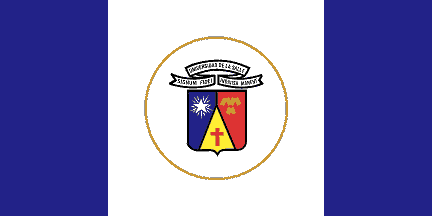 image by Carlos Thompson, 17 March 2003
image by Carlos Thompson, 17 March 2003
Universidad de La Salle, Bogota, Colombia
(University of La Salle) - According to
www.lasalle.edu.co,
the picture shows a blue-white-blue, equally divided vertically
flag, but in the text they say that the white is wider and the
coat of arms is in the middle enclosed by a golden circle.
Carlos Thompson, 17 March 2003
The flag is one of the most representative symbols of the
university, used in main ceremonies, the Day of St. Jean-Baptiste
de La Salle (15 May), graduation ceremonies, special ceremonies.
The graduates of the university shall take the oath on the flag.
The flag shall be half-staffed after the death of students,
professors or administrators of the university, and may cover
their coffin.
Blue represents the sky that covers us, water that feeds us and
freedom, the source of democracy.
White represents the light that enlightens and guides us, ethics,
honesty, dignity and purity in the intentions.
The shield placed in the middle of the flag represents the
"Signum Fidei" (Ring of Faith) of the Institute of the
Brothers of the Christian School (aka De La Salle Brothers).
The shield of the university reflects its origin, philosophy and
project for the future. The shield is of modern shape,
symbolizing the institute as a modern community.
The honour (central) piece of the shield, a pile or issuing from
the base, symbolizes rectitude and honesty that should guide all
the acts of the university, as well as the exemplary
honour of its governors and the commitment to help the
poor and defend the principle of authority. It is charged with a
cross gules, shaped like the cross used by the knight crusaders,
as a symbol of Christian and Catholic faith and of a new crusade
for culture, science and technology led by the university.
The dexter (left) piece, azure, symbolizes serenity and balance.
It is charged with the Lasallian star argent with projections or,
which is the universal symbol of the Lasallian movement.
The sinister (right) piece, gules, symbolizes intrepidity,
heroism and sacrifice. It is charged with three broken chevrons
or taken from the arms of the De La Salle family.
The scroll placed above the shield bears in capital letters
sable, as a symbol of science and knowledge, the name of the
university, the motto of the De La Salle Brothers ("Signum
Fidei", in Latin, "Sign of Faith") and the motto
of the De La Salle family ("Indivisa Manent", in Latin,
"Let us all be united").
The Lasallian star recalls the legend saying that a star fell
from the sky to mark the place where an abbey dedicated to the
Blessed Virgin (here, Our Lady of the Star) should be built. It
also symbolizes the Lasallian teachings guiding the youth.
Another Lasallian
website recalls the history and heraldry of the De La Salle
family as follows:
"The house of De La Salle was first established in Urgel, an
area of Catalonia, Spain, where the form of the family name was
"Salla." The head of the family, Johan Salla, Warrior
in Chief of Atphonus the Chaste, King of Oviedo, expelled the
Moors from Urgel and reestablished the Episcopal See in 818. The
broken legs he sustained during combat as he fought side by side
with his king are the origin of the broken chevrons on the De La
Salle's coat of arms.
In the 13th century, the family migrated to the Basque County in
the south of France, and though their name became French, they
retained "Salla!" as their battle cry. The ancient
motto of the family is "Que sien toustem ligato
amasse," which in Gascon language means "Let us all be
united!" or "Let us all stick together!" The Reims
branch of the family translated this motto into the Latin
"Indivisa Manent," which is the present wording of the
motto on the coat of arms."
Ivan Sache, 27 December 2008
Blue symbolizes the spiritual values while yellow symbolizes the material
values. The colors were selected for their harmonic contrast. The whole design
is based on the "law of harmonic distribution".
The five dissimilar points of the star represent the institutes' philosophy and
objectives.
Source: -
Institute's website
Ivan Sache, 04 July 2011
The flag of the university, as shown on a
blog entry dated 17 October 2011, is vertically divided blue-white-blue (1:2:1)
with the university's coat of arms in the center. On the flag, the scroll
surmounting the coat of arms is azure with letters argent and not argent with
letters azure/sable as on the self-stranding coat of arms.
http://universidaddelasallelu.blogspot.fr - University's blog
However, the university appears to use now a different flag, presented on the
official website, which should be presented first, as follows:
The flag
currently used by the university is vertically divided blue-white-blue, charged
in the center with the university's coat of arms surrounded by a golden-yellow
oval.
http://www.lasalle.edu.co/wps/portal/Home/Principal/LaUniversidad/acerca/simbolos
- Symbols' page, university website; a photo of the flag included
Ivan Sache, 22 August 2017
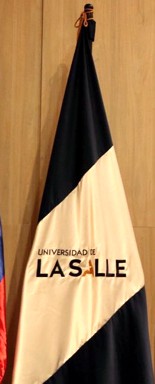 image located by Paul
Bassinson, 31 July 2023
image located by Paul
Bassinson, 31 July 2023
A variant of the flag of Universidad de La Salle from
https://www.facebook.com/photo.php shows the name on the white stripe
rotated to read horizontally when flag is draped.
Paul Bassinson, 31
July 2023
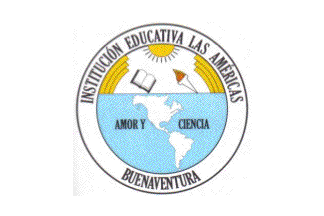 image by Ivan Sache, 09 November 2014
image by Ivan Sache, 09 November 2014
Institución Educativa Las Américas was established in Las Américas borough,
part of the municipality of Buenaventura (Valle Department) by Decree No. 1,818
of 4 September 2002, as the merger of Centro Docente Las Américas and Centro
Docente Carlos Holmes Trujillo.
The symbols of the institute are described in the institute's Strategic Plan of
Management. The flag is white with the institute's emblem in the middle. White
is a symbol of peace, love, and tranquility.
The emblem of the institute is made of a disk horizontally divided into two
parts. The upper part is a symbol of knowledge, aspiration, triumph, and
rebirth, represented by a book, the sun, and a torch. The lower part features
the map of the Americas, surrounded by the "two seas" of Colombia [Pacific and
Atlantic Oceans], as a symbol of fraternity, unity, and projection. It is
inscribed with the motto "AMOR Y CIENCIA" (Love and Science).
Source:
ftp://ftp.unicauca.edu.co/cuentas/cpe/docs/Valle/Ponentes/Buenaventura/Sede%20las%20am%E9ricas%20la%20dignidad%20y%20carlos%20holmes%20trujillo/Plan_Estrategico_Gestion.pdf
Ivan Sache, 09 November 2014
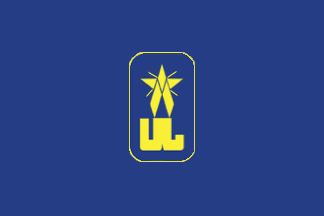 image by Ivan Sache, 26 October 2019
image by Ivan Sache, 26 October 2019
Corporación Universitaria Lasallista (Lasallian University Corporation) was
imagined in 1977 by Juan Ernesto Vélez Escobar and other alumni of Colegio de
San José De La Salle members of ALDEA (Asociación Lasallista de Exalumnos -
Alumni Lasallian Association), as a means of offering Lasallian education beyond
the primary and secondary levels.
Corporación Universitaria Lasallista was
constituted on 16 May 1982 in
Colegio de San José De La Salle; classes
started on 6 February 1984 with 161 students.
Originally housed in
Colegio de San José De La Salle, located on Boston borough, Medellín (today the
site of the astronomic observatory and of the museum of life sciences operated
by the Lasallian brothers), the university was transferred in 2001 to Caldas
(Antioquia), 20 km of Medellín.
https://site.lasallista.edu.co/
Official website
The flag of the
university is dark blue with the university's emblem in the center.
The
emblem features the Signum Fidei (Star of Faith) from the coat of arms of the
Institute of the Brothers of the Christian Schools, above the letters "UL",
standing for "Universitaria" and "Lasallista", respectively.
Photo
https://www.lasallenorandino.org/inicio/354-posesion-del-nuevo-rector-de-la-corporacion-universitaria-lasallista
Ivan Sache, 26 October 2019
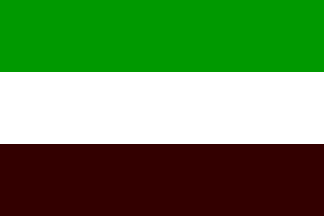 image by Ivan Sache, 07 July 2011
image by Ivan Sache, 07 July 2011
"Institución Educativa Las Marías" is located in Olaya Herrera (Nariño
Department); the institute is part of a ethno-educational project aimed at the
preservation of the cultural and traditional practices of the local
Afro-Colombian communities.
The flag of the institute, as shown graphically and described on the institute's
website, is horizontally divided green-white-coffee brown. Green represents the
resources of the woods, white represents peace and coffee brown represents the
soil producing our daily resources.
Source:
http://lasmarias.edu.co/web/?page_id=32
Ivan Sache, 07 July 2011
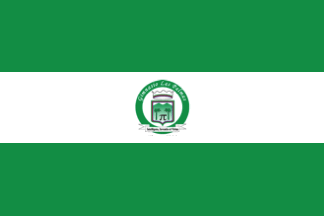 image by Ivan Sache, 1 January 2021
image by Ivan Sache, 1 January 2021
Gimnasio Las Palmas is located in Bogotá.
The flag of Gimnasio Las
Palmas is horizontally divided green-white-green with the school's emblem in the
center.
Photos
http://colegiosporbogota.com/loc1.html
https://www.facebook.com/gimpalmas/photos/3663545417022526
https://www.facebook.com/gimpalmas/posts/2349829058394175
Ivan Sache,
1 January 2021
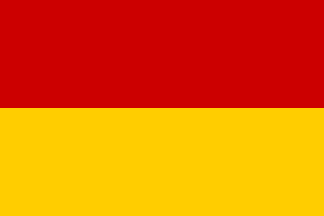 image by Eugene Ipavec, 18 February 2007
image by Eugene Ipavec, 18 February 2007
The Universidad Autónoma Latinoamericana (Latin American
Autonomous University) is located in Medellín,
The university flag can be seen at <www.unaula.edu.co>.
Description of the Flag: "Conceived by attorney Ramón
Emilio Arcila Hurtado; approved simoultaneously with arms.
Consists of two stripes of equal size: the first, (top) red one
symbollizes the University's fight and sacrifice to rejects
tradition and embrace progress. The second, (lower) mustard one
represents a lively and glowing university, with a diversity of
ideologies and creeds"
Ron Lahav and Eugene Ipavec, 18 February 2007
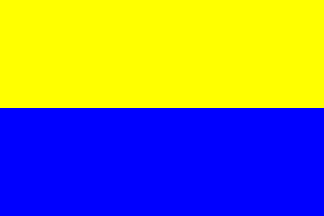 image by Ivan Sache, 28 July 2014
image by Ivan Sache, 28 July 2014
Liceo Latinoamericano del Sur was established in 1989 in La Cabaña borough,
part of the municipality of Bosa (Bogotá), by Sisters Martha Ines and Stella
Girón Avendaño. Classes started in February 1990.
The flag of the institute is prescribed in Chapter 2.1 of the institute's
Etiquette Guidebook, as horizontally divided yellow-blue with the institute's
emblem in the middle. Yellow is a symbol of energy, prosperity, and
abundance. Blue is a symbol of sincerity and responsibility
Source:
http://www.liceolatinoamericano.co/el-liceo/manual-de-convivencia/ -
Institute's Etiquette Guidebook
The flag used in official street parades does not bear the coat of arms.
Photos:
http://www.liceolatinoamericano.co/wp-content/gallery/20-julio-2012/sam_1001.jpg
http://www.liceolatinoamericano.co/wp-content/gallery/carrera2011/s6300228.jpg
http://www.liceolatinoamericano.co/wp-content/gallery/20julio2011/dsc00144.jpg
Ivan Sache, 28 July 2014